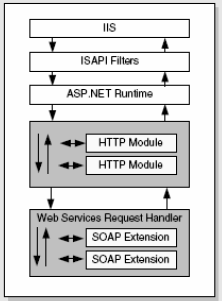一、 WebService概述
1、 性能
?设计时就考虑性能
?不要在事后再加入性能!
?在项目开发的整个过程中反复测试
?两种量化Web性能的方法:
1) 机器吞吐率(requests/sec)
2) 响应时间(time tofirst/last bytes)
2、面向对象
?应用于同一平台和运行环境
?共享类型而不是schemas
?采用便宜, 透明通信
?对象的标识与生命周期由系统维护
?客户机和服务器的同步的部署
?容易概念化,因而提供一个自然的模型
?一般不需要状态管理
?应用于一个可预测的序列、期限和结果
?目标是远程透明地使用方法和类型
3、面向服务
? 应用于异构平台和运行环境
? 共享schemas而不是类型
? 采用高成本, 明确通信
? 服务是自治的: 安全和失效是隔离
? 允许的连续, 分离部署客户机和服务器
? 基于软件组件和分布的对象,依赖服务的协议
? 拥有并维护状态
? 基于消息, 异步的, 和长通信
? 目标是提供服务隔离和调用的标准。
4、Web Service性能设计的考虑
? 设计"大块头"的接口减少往返。
? 基于消息的编程而不是远程过程调用(RPC) 。
? 使用XML字串作为参数。
? 尽量使用原始数据类型参数。
? 避免在调用之间维护服务器状态。
? 考虑为复杂的WebMethod提供输入校验。
? 考虑对WebMethod的结果进行缓存。
? 选择适用的大数据包传送方式。
? 避免调用本地的WebService。
5、基于消息编程和RPC
? 消息
//Client
string msg = "<Items>...</Items>";
MyMethod(msg);
//Server
[WebMethod]
void MyMethod(string msg){ . . . }
? RPC
Serv.SendItemsToBePurchased(Array[] items);
Serv.ShippingAddress(string Address);
Serv.CheckOut();
二、WebService性能最佳实践
? 连接与线程优化
? WebMethod的优化
? 高效地调用WebMethod
? 设置超时
? 缓存
? 状态管理
1、连接
?配置maxconnection 属性。
示例:
<connectionManagement>
<add address="*" maxconnection="12"/>
</connectionManagement>
修改:
<connectionManagement>
<add address="WebServiceA" maxconnection="8">
<add address="WebServiceB" maxconnection="4">
</connectionManagement>
?对WebService按优先级分配连接资源
?使用单一身份进行调用。
serv = new WebService1();
serv.PreAuthenticate=true;
ICredentials conCredentials =new
NetworkCredential("UId","Pwd","NPSTest" );
serv.Credentials = conCredentials;
serv.AllowAutoRedirect=false;
serv.ConnectionGroupName = "SameForAllUsers";
?为集成认证使用UnsafeAuthenticatedConnectionSharing 。
?为基本验证使用PreAuthenticate 。
2、WebMethods
?使用原始类型参数。
?考虑使用缓冲。
?将WebMethod的返回缓存。
?只在需要会话状态时才使用它。
大数据包的处理
?使用字节数组作为参数或返回值
?返回一个URL
?使用串行化流
<configuration>
<system.web>
<httpRuntime maxRequestLength="8096"
useFullyQualifiedRedirectUrl="true"
executionTimeout="45"/>
</system.web>
</configuration>
串行化
?使用XmlIgnore减少串行化。
?减少往返。
?考虑使用XML 压缩。
public class MyClass
{
// The str1 value will be serialized.
public string str1;
/* This field will be ignored when
serialized--unless it's overridden. */
[XmlIgnoreAttribute]
public string str2;
}
异步WebMethod
?用异步Webmethods对I/O 操作。
?当Webmethods依赖于工作线程时,不要使用异步。
//webservice
[WebMethod]
IAsyncResult BeginMyProc(...) //the WSDL will show the method as MyProc(...)
[WebMethod]
EndMyProc(...)
单工通信
?如果不需要返回,考虑使用OneWay属性。
[SoapDocumentMethod(OneWay=true)]
[WebMethod(Description="Return immediately")]
public void SomeMethod()
{...}
COM交互
?建议: 尽量避免交互
?最好将COM代码移植到.NET
?可能会很昂贵, 尤其对于数组操作
?“受管” 与“不受管” 转换
?注意单元线程组件
?缺省情况ASP.NET 使用MTA线程
?损害STA 组件性能
注意所有VB6组件!
3、异步调用
?当有并发任务时例用异步调用WebService。
?使用异步调用多个不相关的WebService。
?异步叫调用WebService可以增加UI 响应。
4、超时
?适当地设置代理的超时。
?设置您的ASP.NET 超时大于您的WebService的超时。
?如果页面超时,则放弃页面与WebService的连接。
MyWebServ obj = new MyWebServ();
obj.Timeout = 15000; // in milliseconds
5、缓存
?对时效性不强的数据进行缓存。
?考虑提供与缓存所相关的信息给客户。
?考虑使用边界缓存,如ISA上的缓存。
6、状态管理
?只在需要会话状态时才使用它。
?减少应用状态与服务器的亲合力。
?InProc
?StateServer
?SQLServer
注:主要资料来自王兴明的WebCast。
Demo下载























 2156
2156

 被折叠的 条评论
为什么被折叠?
被折叠的 条评论
为什么被折叠?








